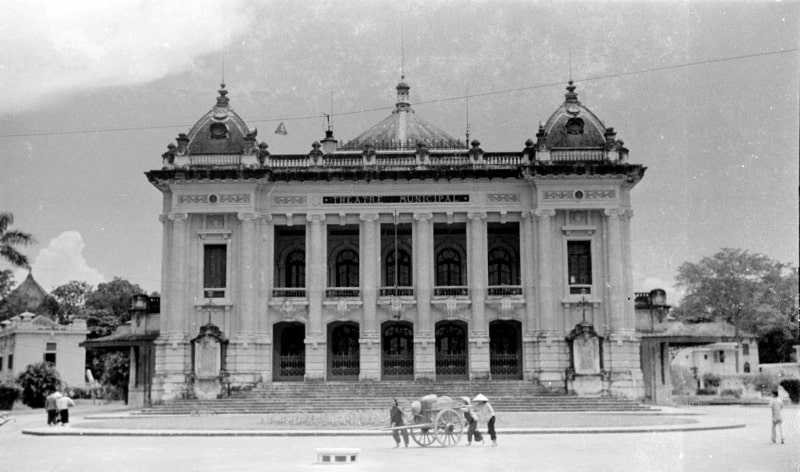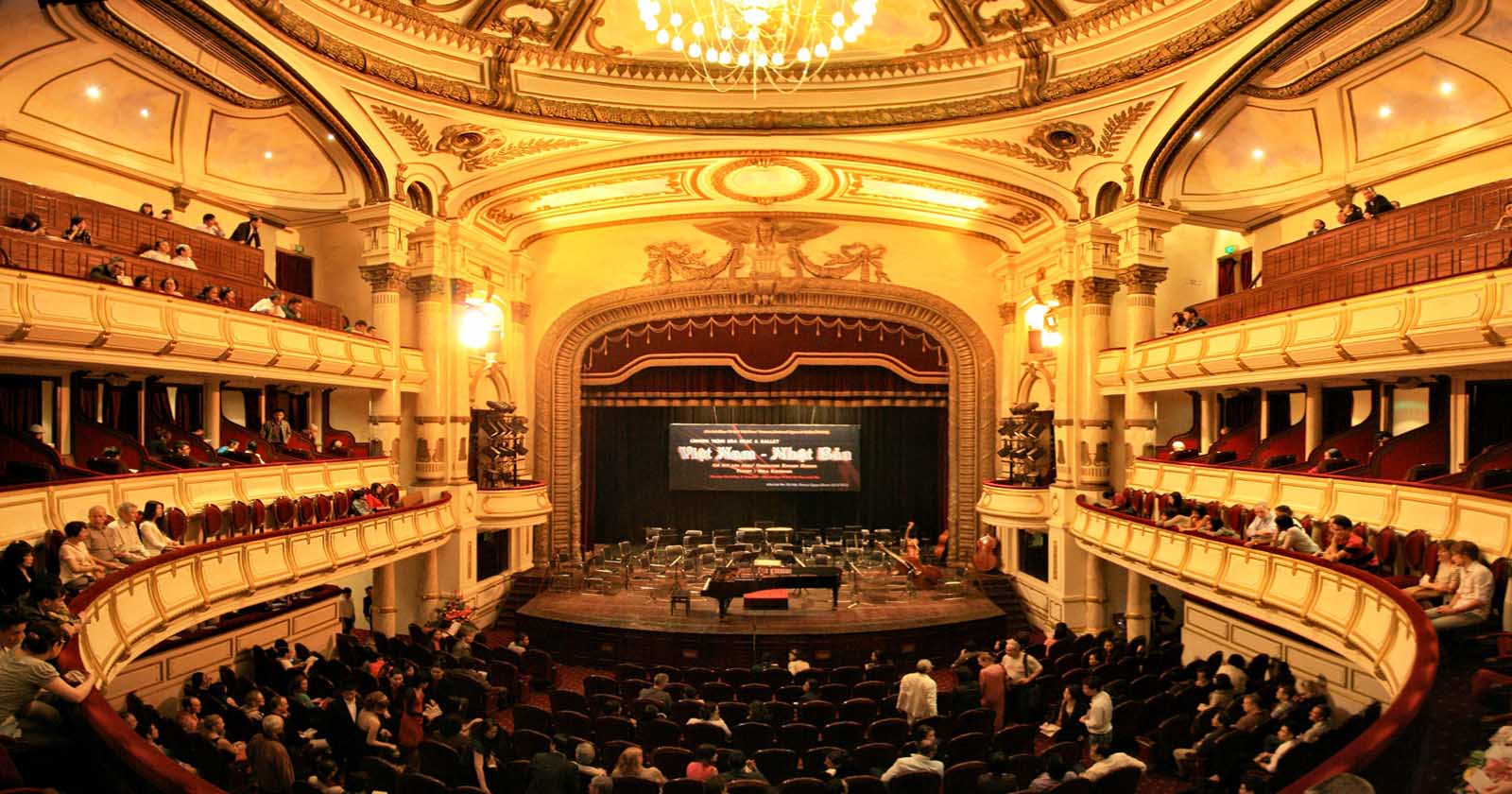History of the Hanoi Opera House
The history of the Hanoi Opera House dates back to the early 20th century, during the French colonial period in Vietnam. Construction began in 1901, with the opera house designed by French architects inspired by the Palais Garnier in Paris. Completed in 1911, it quickly became the centerpiece of Hanoi’s cultural life, hosting performances for French officials, wealthy expatriates, and local elites.During the colonial era, the opera house was not just a venue for entertainment but also a political symbol of French power and influence. However, after Vietnam gained independence, the building took on a new role, becoming a symbol of national pride and cultural preservation. It was at the Hanoi Opera House that the first National Assembly of Vietnam convened in 1946, marking an important moment in the country’s modern history.
History of the Hanoi Opera House
Architectural Design of the Opera House
The Hanoi Opera House is a stunning example of French neoclassical architecture, reflecting the grandeur of European theaters while incorporating local elements. The building’s design was heavily influenced by the Palais Garnier, with its ornate façade, tall columns, and elaborate stonework. The opera house stands as a tribute to French architectural ingenuity while showcasing Vietnam’s colonial past.Notable features of the opera house include its sweeping staircases, marble flooring, and intricate chandeliers, all of which add to its majestic appearance. The exterior of the building is adorned with classical motifs, giving it a timeless elegance that continues to captivate visitors. Inside, the auditorium seats over 600 people and is known for its excellent acoustics, making it a premier venue for concerts, ballets, and operatic performances.
Architectural Design of the Opera House
Location and Accessibility
The Hanoi Opera House is situated at 1 Trang Tien Street, near the iconic Hoan Kiem Lake, one of the most popular tourist areas in the city. This prime location makes it easy for visitors to combine a trip to the opera house with other nearby attractions such as the Old Quarter, Ngoc Son Temple, and the Thang Long Water Puppet Theatre.Getting to the Hanoi Opera House is convenient whether you’re traveling by taxi, motorbike, or on foot. The area is well-served by public transportation, and many visitors find it enjoyable to walk through Hanoi’s vibrant streets to reach the opera house. Parking is available nearby, and several restaurants and cafes in the vicinity make it a perfect spot to explore before or after attending a performance.Cultural and Artistic Significance
The Hanoi Opera House holds a special place in Vietnam’s artistic heritage. Since its opening, it has been a hub for cultural exchange, hosting performances that range from traditional Vietnamese music to Western classical concerts. The opera house is known for its diverse program of events, which includes operas, ballets, orchestral concerts, and theatrical performances, making it a key player in the promotion of both Vietnamese and international arts.Over the years, the Hanoi Opera House has hosted many prominent artists and performances. From classical operas like “Carmen” and “La Traviata” to traditional Vietnamese performances, the venue has become a melting pot of artistic expression. For many local artists, performing at the opera house is seen as a pinnacle of achievement, and its role in nurturing the arts in Vietnam cannot be overstated.Events and Performances
The Hanoi Opera House regularly hosts a wide variety of performances, appealing to both local audiences and international visitors. Its repertoire includes:- Classical music concerts: Featuring both Vietnamese and international orchestras and soloists.
- Opera performances: With famous works from composers like Mozart, Verdi, and Puccini.
- Ballet: Showcasing both classical ballet and contemporary dance productions.
- Traditional Vietnamese music: Highlighting the country’s rich musical heritage, with performances featuring traditional instruments and folk songs.
- Modern performances: Including contemporary music concerts, jazz shows, and experimental theater.

Opera performances
Some of the most famous productions staged at the Hanoi Opera House include Tchaikovsky’s “Swan Lake” and Verdi’s “Aida”, as well as more modern works by Vietnamese composers and playwrights. These performances provide visitors with an opportunity to experience the depth and diversity of Vietnam’s arts scene.Inside the Hanoi Opera House
Stepping inside the Hanoi Opera House is like taking a journey back in time. The interior is as impressive as the exterior, with a grand marble staircase leading up to the auditorium, which seats approximately 600 people. The seating arrangement is designed to give all guests an intimate experience with excellent sightlines and acoustics.The main stage is equipped with modern lighting and sound systems, making it ideal for large-scale productions. The combination of classical architectural design and state-of-the-art technology creates an immersive environment for performances. Visitors are often struck by the attention to detail, from the gold-leafed decorations to the luxurious velvet curtains.Guided Tours of the Opera House
For those interested in learning more about the opera house’s history and architecture, guided tours are available. These tours provide visitors with a behind-the-scenes look at the building, offering insight into its construction, design, and the role it has played in Hanoi’s cultural life.During the tour, guests can explore areas that are not usually open to the public, including the dressing rooms and rehearsal spaces. The guides often share fascinating stories about the opera house’s past, making it an educational experience for visitors of all ages. Tours are available in multiple languages, including English, making them accessible for international tourists.Restoration and Preservation Efforts
Over the years, the Hanoi Opera House has undergone several renovations to preserve its historical integrity and ensure it remains a world-class performing arts venue. One of the most significant restorations took place in the 1990s, when the Vietnamese government, with support from French experts, invested in restoring the building to its former glory.These restoration efforts focused on preserving the building’s original architectural features while updating its facilities to meet modern standards. Today, the Hanoi Opera House stands as a well-preserved example of colonial-era architecture and continues to serve as a cultural landmark in Hanoi.Hanoi Opera House and French Influence
The French influence on the Hanoi Opera House is unmistakable, from its neoclassical design to its role in the cultural life of the city. During the colonial period, the opera house was built to resemble European theaters, reflecting France’s desire to create a “Little Paris” in Vietnam.While the opera house is a symbol of colonial power, it also represents the blending of French and Vietnamese cultures. After independence, the building was repurposed to serve the people of Vietnam, and today it is a testament to the country’s ability to adapt and integrate different cultural influences.Hanoi Opera House in Modern Times
Today, the Hanoi Opera House continues to be a vital part of Vietnam’s cultural scene. It serves not only as a venue for performances but also as a space for cultural exchange and education. The building remains a popular tourist attraction, drawing visitors who come to admire its architecture, learn about its history, or attend a performance.In recent years, the opera house has expanded its repertoire to include more modern performances, appealing to a younger generation of artists and audiences. It has also played a key role in the development of Vietnam’s performing arts, supporting local talent and bringing international productions to Hanoi.Unique Experiences for Visitors
Attending a performance at the Hanoi Opera House is a unique cultural experience that should not be missed. Whether it is a classical concert, a ballet, or a traditional Vietnamese performance, the setting adds an extra layer of grandeur to the event. For those unable to attend a performance, simply visiting the opera house and taking a tour provides a glimpse into its historical and architectural significance.Photography is allowed in certain areas of the building, and many visitors enjoy capturing the opera house’s beautiful details. Special events, such as the Hanoi Opera Festival, offer even more opportunities for visitors to engage with the venue.Hanoi Opera House vs. Saigon Opera House
Vietnam is home to two iconic opera houses: the Hanoi Opera House and the Saigon Opera House (Ho Chi Minh City). While both share French colonial origins, they differ in architectural style and historical significance. The Saigon Opera House is smaller and more modern in appearance, while the Hanoi Opera House retains a grander, more classical style.Both opera houses play important roles in their respective cities’ cultural lives, but the Hanoi Opera House is often considered the more historically significant due to its role in Vietnam’s political and cultural history.Tips for Visiting the Hanoi Opera House
- Best time to visit: The opera house is open year-round, but it’s best to attend a performance in the evening for the full experience.
- Ticket purchasing: Tickets for performances can be purchased online or at the box office. It’s advisable to book in advance, especially for popular shows.
- Etiquette: Visitors are expected to dress appropriately for performances, and it’s important to remain quiet during shows to respect the performers and other guests.
Conclusion: Why Hanoi Opera House is a Must-Visit
The Hanoi Opera House is not just a building—it is a living monument to Vietnam’s artistic and cultural heritage. Whether you’re an architecture enthusiast, a history buff, or a lover of the performing arts, the Hanoi Opera House offers an unforgettable experience. Its rich history, stunning design, and ongoing role in Hanoi’s cultural life make it a must-visit for anyone traveling to Vietnam’s capital.
Don’t miss the chance to explore one of Hanoi’s most iconic landmarks! Whether you’re attending a world-class performance or taking a guided tour, the Hanoi Opera House offers a unique blend of history, culture, and architectural beauty. Plan your visit today to experience the grandeur of this French colonial masterpiece and immerse yourself in Vietnam’s vibrant arts scene. Book your tickets or schedule a tour with YESD for an unforgettable experience!
